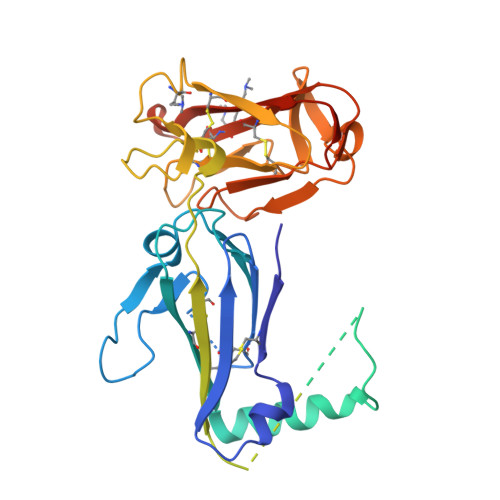The Structure of Plasmodium falciparum Blood-Stage 6-Cys Protein Pf41 Reveals an Unexpected Intra-Domain Insertion Required for Pf12 Coordination.
Parker, M.L., Peng, F., Boulanger, M.J.(2015) PLoS One 10: e0139407-e0139407
- PubMed: 26414347
- DOI: https://doi.org/10.1371/journal.pone.0139407
- Primary Citation of Related Structures:
4YS4 - PubMed Abstract:
Plasmodium falciparum is an apicomplexan parasite and the etiological agent of severe human malaria. The complex P. falciparum life cycle is supported by a diverse repertoire of surface proteins including the family of 6-Cys s48/45 antigens. Of these, Pf41 is localized to the surface of the blood-stage merozoite through its interaction with the glycophosphatidylinositol-anchored Pf12. Our recent structural characterization of Pf12 revealed two juxtaposed 6-Cys domains (D1 and D2). Pf41, however, contains an additional segment of 120 residues predicted to form a large spacer separating its two 6-Cys domains. To gain insight into the assembly mechanism and overall architecture of the Pf12-Pf41 complex, we first determined the 2.45 Å resolution crystal structure of Pf41 using zinc single-wavelength anomalous dispersion. Structural analysis revealed an unexpected domain organization where the Pf41 6-Cys domains are, in fact, intimately associated and the additional residues instead map predominately to an inserted domain-like region (ID) located between two β-strands in D1. Notably, the ID is largely proteolyzed in the final structure suggesting inherent flexibility. To assess the contribution of the ID to complex formation, we engineered a form of Pf41 where the ID was replaced by a short glycine-serine linker and showed by isothermal titration calorimetry that binding to Pf12 was abrogated. Finally, protease protection assays showed that the proteolytic susceptibility of the ID was significantly reduced in the complex, consistent with the Pf41 ID directly engaging Pf12. Collectively, these data establish the architectural organization of Pf41 and define an essential role for the Pf41 ID in promoting assembly of the Pf12-Pf41 heterodimeric complex.
Organizational Affiliation:
Department of Biochemistry & Microbiology, University of Victoria, Victoria, British Columbia, Canada.


















